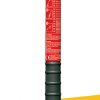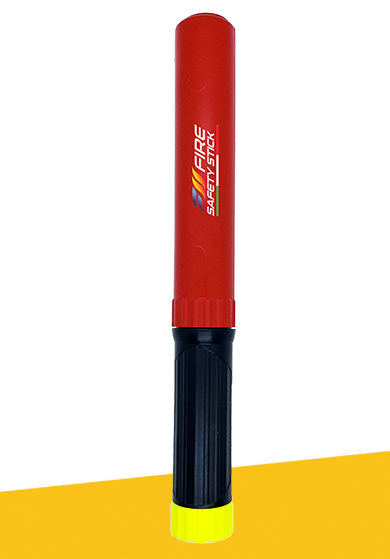Description
Fire Safety Stick 100 Second – FSS100
Fire Safety Stick 50 Second – FSS100 is a new fire extinguisher that every home, boat, caravan, motorhome and even toolkit should have.
How does the Fire Safety Stick it work?
The Fire Safety Stick (FSS) is a manual, portable fire extinguishing device. It uses a Potassium powder jet (a unique method among conventional fire extinguishers) that employs the vaporisation of the powder in the environment followed by the condensation of its extinguishing substance. It works by interrupting a fire’s chain of reaction (the “auto-catalyst” of the fire).
Fire Safety Stick is composed of stable, solid minerals; it does not contain gas and is not pressurised. The aerosol-like jet is only produced when the charger is struck with its base. The produced aerosol jet is free of thrust and is essentially an inert salt that emits gas already present in the atmosphere.
• Works on ALL major Fire Classes.
• Lasts far LONGER to fight the Fire.
• Leaves NO damaging mess or residue.
• Small & Light.
• Safe & Easy to use.
• No servicing or maintenance.
• 10 year shelf life
Here’s the chemistry behind it
This process allows the stick to extinguish all types of fires through saturation, while its slow bio-degradation in the environment, further prevents the likelihood of subsequent fires.
The extinguishing process involves two different reactions: one is physical and the other, chemical. The physical reaction relates to potassium’s tendency to oxidise rapidly in air. When in contact with air, alkaline salts consume great quantities of oxygen, thus depriving fires of oxygen. Then the chemical reaction is created through the stable link between potassium particles and the fire’s combustion particles.
Through the two reactions, a quick oxidation process takes place, immediately transforming the jet from a solid state into a gaseous state freeing the potassium particles. These atoms are able to intercept and interrupt any other free particles produced by the fire’s natural chain reaction combustion process.
Potassium has strong inhibitor qualities due to its weak ionization energies. The extinguishing agent being used is composed of Potassium Nitrate, organic oxidizer, and plasticizer resin.
When Potassium Nitrate (KNO3) discharges from the extinguisher it vaporizes in the environment followed by the condensation of its extinguishing substance. When it reacts (inside the body of the extinguisher) it breaks down and the aerosol that is formed is made up primarily of free radicals of Potassium K+, of Nitrogen N (an inert gas), and water vapour.
The aerosol that comes out of the unit reacts with the fire. Potassium radicals (K+) capture the Oxygen of the combustion thereby extinguishing it.
At the end of the extinguishing process the following is discharged to the atmosphere:
As a solid: particles of Potassium (that have reacted with the Oxygen of the fire) having a size between 3-4 microns. These particles are invisible at sight and heavier than air. They disperse in the atmosphere and tend to deposit on the ground in no appreciable amounts.
As a gas: As Nitrogen; an inert gas already present in the air we breathe at more or less 78%.
As water vapour (and lastly) extremely minimal toxic by-products that are a result of the combustion process.
Whats the best way to tackle a fire with it?
Unlike a dry chemical extinguisher that combats a blaze by depositing a large amount of solid powder on the fire, the Fire Safety Stick fights a fire by releasing a gas. This gas attaches itself to the oxygen surrounding the fire robbing its ability to stick to the chain of combustion (without affecting ones ability to breath that oxygen). The goal is therefore to use the gas coming out the FSS to create a ‘cloud of containment’ around a fire. Creating a cloud that prevents any outside and un-attached oxygen from getting to the fire is essential and is the same strategy that should also be used with a Halon/Halotron or CO2 extinguisher.
The two worst things you can do when fighting a fire with a gas extinguisher is to be too close or to rush the process. Being very close to a fire means that a cloud cannot be formed blocking any new oxygen that will continue to feed the flame. This is particularly problematic in an isolated pan situation where being too close will only chase the flames around. Rushing the process by moving the extinguisher around a lot also prevents a cloud from being formed and diminishes the performance of the extinguisher.
The best technique is to take advantage of the long discharge time offered by the Fire Safety Stick and to approach a fire from a moderate distance progressively getting closer to its source. During the approach, move the FSS slowly around the fire always directing towards the centre. This will contain the fire and allow the gas the ability to work.
Tight areas with lots of pockets (like the engine bay of a car for example) brings out the strengths of the FSS as the gas, which is heavier than air, will fill all the voids not directly accessible; both putting out a fire and preventing a re-flash.










